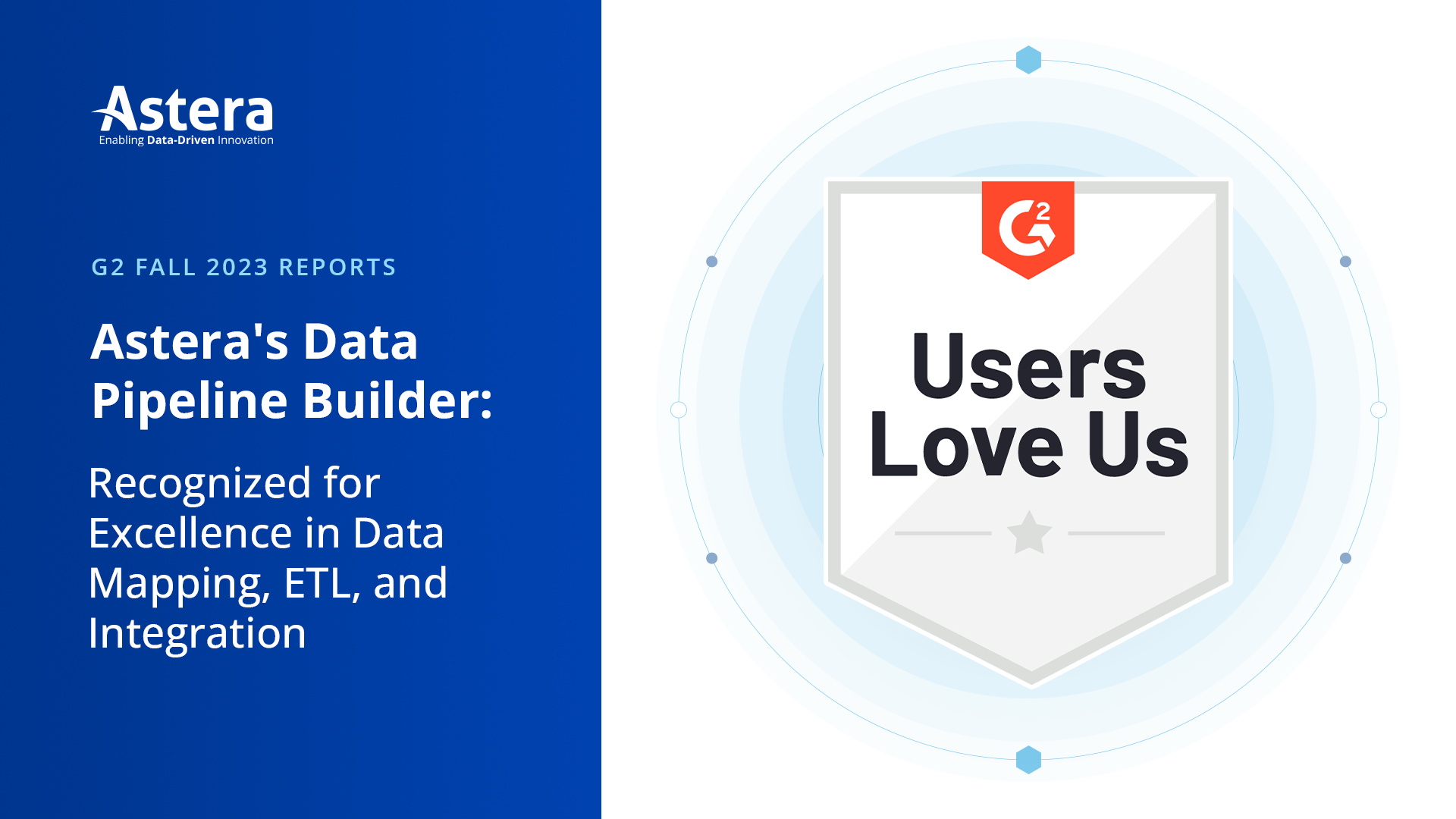
How to Build a Data Pipeline: A Step-by-Step Guide
Data plays a significant role in business growth and digital initiatives for approximately 94% of enterprises. However, the full potential of these data assets often remains untapped, primarily due to the scattered nature of the data.
The solution lies in constructing a structured data pipeline, a task that can be resource-intensive and time-consuming. A simple pipeline may take weeks to build, while a more complex one could span months. Therefore, it is imperative for your organization to invest in appropriate tools and technologies to streamline the process of building a data pipeline.
This blog details how to build a data pipeline effectively step by step, offering insights and best practices for a seamless and efficient development process.
Get Started with Faster, Smarter Data Pipelines
Ready to cut down on time and effort in your ETL projects? Discover Astera Data Pipeline Builder today and see how AI-powered automation can simplify your data handling, no coding needed.
Request a DemoHow To Build a Data Pipeline
Building a data pipeline is a multi-step process that requires careful planning and execution. Here are eight steps to build a data pipeline:
Step 1: Define Your Goals
The first step in building a data pipeline is to clearly outline your objectives. These could be to enable real-time analytics, facilitate machine learning models, or ensure data synchronization across systems. Your goals will guide the design, complexity, and scalability of your pipeline. Consider the specific data requirements, the frequency of data updates, and the desired speed of data processing and analysis.
Step 2: Identify Data Sources
Recognizing your data sources is a crucial step in building a data pipeline. Data sources can be broadly divided into six categories:
- Databases: Databases could be relational like MySQL, PostgreSQL, or non-relational like MongoDB, Cassandra.
- Cloud Storage: Data can also be stored in cloud platforms like AWS S3, Google Cloud Storage, or Azure Blob Storage.
- Real-time Data Streams: These are continuous data sources like IoT devices, social media feeds, or log files.
- File Sources: Data may originate from files, including formats such as CSV, Excel, JSON, or other file-based storage systems.
- APIs (Application Programming Interfaces): Data can be extracted from APIs that provide a direct connection to various web services and external platforms.”
Understanding the nature, format, and volume of these data sources is essential as it impacts the subsequent stages of ingestion and transformation.
Step 3: Determine the Data Ingestion Strategy
Next, you need to extract, integrate and incorporate data from diverse sources into your pipeline. There are two primary methods of data ingestion:
- Batch Ingestion: This method involves collecting data over a specific period and processing it as a group. It’s suitable for large volumes of static data where real-time insights are not required.
- Real-time Ingestion: In this method, data is processed immediately as it arrives. It’s ideal for scenarios where real-time insights are crucial, such as fraud detection or system monitoring.
Step 4: Design the Data Processing Plan
You’ll need to clean, validate, and structure the ingested data into a format suitable for analysis. There are two main approaches to data transformation:
- ETL (Extract, Transform, Load): Here, you extract data from the source onto a staging server, transform it, and then load it into the destination. This approach is typically used when dealing with smaller volumes of data or when the transformed data needs to be used by multiple downstream applications.
- ELT (Extract, Load, Transform): In this approach, you extract data from the source, load it into the destination, and then transform it within the destination server. This eliminates the need to load data on a staging server, making it preferable for handling larger volumes of data in a big data environment. The data transformation process in ELT is similar to ETL but occurs after the data has been loaded into the destination.
Step 5: Decide Where to Store the Information
Next, you’ll store the processed data for further use. This could be a traditional data warehouse like Amazon Redshift for structured data, a data lake like Google Cloud Storage for semi-structured or unstructured data, or a database system like PostgreSQL for transactional data. The choice of destination depends on the nature of the data, the use case, and the specific data analytics requirements.
Step 6: Establish the Workflow
At this stage, it’s important to define the sequence of operations in the pipeline. This includes specifying the order of tasks, managing dependencies between tasks, handling errors, and setting up retries or notifications in case of failure.
This step is crucial to ensure the smooth operation of the pipeline and to handle any issues that might arise promptly. It involves creating data validation checks and defining procedures for error handling and recovery.
Step 7: Set a Monitoring Framework
It’s crucial to monitor data pipeline performance to ensure it’s working as expected. This involves tracking the flow of data through the pipeline, checking for errors or bottlenecks that might slow down data processing, and monitoring resource usage to ensure the pipeline is operating efficiently. Monitoring helps detect and resolve issues before they affect the performance of the pipeline or data quality.
Step 8: Implement Data Consumption Layer
Finally, you’ll need to create a reliable interface through which end-users or applications access the processed data. This could be a business intelligence (BI) tool that provides data visualization capabilities, a reporting tool that generates detailed reports, or an API that allows other applications to interact with the data. The data consumption layer needs to be designed to easy access to the data.
How to Build a Data Pipeline: Best Practices to Follow
- Streamline Development and Deployment: Implementing Continuous Integration/Continuous Deployment (CI/CD) is key here. CI/CD automates the process of integrating code changes and deploying those changes to the production environment. This means that any updates or improvements to the pipeline can be implemented rapidly and reliably, ensuring the pipeline is always operating at its best.
- Maintain Consistency: Version control systems help achieve consistency in collaborative development environments. They track and manage changes to the codebase, enabling simultaneous work without overwriting changes and providing the ability to revert to previous code versions when necessary.
- Optimize Data Management: Data partitioning divides a large database into smaller, more manageable segments based on specific criteria, improving query performance and streamlining data management tasks.
- Leverage Modern Architectures: Modern software architectures like containers and microservices can significantly improve the scalability and reliability of your data pipeline. Containers encapsulate an application and its dependencies into a single unit that can run consistently across platforms. Microservices create an application as a collection of independent services, promoting better scalability and easier debugging.
- Ensure Data Security: As data moves through various stages of the pipeline, from extraction and transformation to loading, it’s crucial to protect it from unauthorized access and potential breaches. This involves implementing data encryption, access controls, and regular vulnerability testing to protect sensitive information. Compliance with relevant data safety regulations, such as GDPR and HIPAA, is essential, particularly in sectors dealing with personal data, such as healthcare and finance.
Shifting from Manual to Automated Data Pipelines
Building data pipelines manually (Python for data pipelines) is inherently a time-consuming and resource-intensive process, making it susceptible to delays, errors, and inefficiencies. The transition to automated data pipeline tools addresses these challenges, streamlining processes for greater efficiency and resource optimization.
These advanced tools play a pivotal role in streamlining the entire process, offering advantages such as reduced development time, minimized errors, and enhanced scalability. By automating repetitive tasks, they allow organizations to expedite pipeline development while maintaining a high level of accuracy.
Create Data Pipelines Easily with Astera

Astera Data Pipeline Builder brings all of these automation capabilities together. It simplifies data integration, offers scalability, and comes equipped with features to maintain data security and compliance. It’s a powerful cloud-based solution that supports data varying latencies and combines all aspects of a data workflow in one place.
With its user-friendly interface and powerful, AI-driven features, ADPB reduces the effort and time needed to build a robust data pipeline, allowing businesses to focus more on leveraging their data for insights and decision-making.
Here’s how to build a data pipeline with Astera in only five steps:
- Data Extraction: Astera allows you to extract data from a wide range of sources. This includes various databases like SQL Server, Oracle, and MySQL, file formats such as Excel, CSV, XML, and JSON, and cloud applications like Salesforce and Microsoft Dynamics 365, ensuring a comprehensive data collection process.
- Data Transformation: Once the data is extracted, Astera provides a variety of transformation functions that you can use to clean, format, and structure your data as per your requirements. For example, you can use these functions to remove duplicates, convert data types, or aggregate data based on specific criteria.
- Data Loading: After the data is transformed, Astera enables you to load it into your desired destination, be it a database, a data warehouse, or a file system. You could load the data into an SQL Server database, a cloud-based data warehouse like Amazon Redshift, or even export it as a CSV file.
- Automation and Scheduling: Astera also provides features for automating and scheduling your data pipeline tasks. This means that once you’ve set up your pipeline, you can have it run automatically at scheduled intervals or triggered by certain events, reducing manual effort and ensuring your data is always up to date.
- Monitoring and Error Handling: Astera provides real-time monitoring capabilities, allowing you to track the performance of your data pipeline and quickly identify and resolve any issues.
Upgrade from manual to automated data pipelines today! Download Astera Data Pipeline Builder’s 14-day free trial and transform your data workflows.
Build Automated Data Pipelines With Just a Few Clicks!
With Astera's robust features and automation capabilities, you can effortlessly build and deploy data pipelines, saving time and enhancing efficiency.
Download Free TrialWhat is a data pipeline?
What are the key components of a data pipeline?
• Data Sources – Databases, APIs, files, and streaming platforms.
• Data Ingestion – Extracting and loading raw data into the pipeline.
• Data Processing – Transforming, cleaning, and enriching the data.
• Data Storage – Storing processed data in a data warehouse or lake.
• Data Orchestration – Automating and managing pipeline workflows.
• Data Visualization & Analytics – Using BI tools for insights.
How can a no-code tool like Astera simplify data pipeline development?
• Pre-built connectors for databases, cloud storage, and APIs.
• Automated data transformation and cleansing.
• Workflow orchestration to streamline complex data processes.
What are the biggest challenges when building a data pipeline?
• Data Quality Issues – Handling missing, inconsistent, or duplicate data.
• Scalability – Ensuring pipelines can handle increasing data volumes.
• Integration Complexity – Connecting multiple data sources and formats.
• Real-time Processing – Managing latency and data consistency.
• Pipeline Failures – Detecting and recovering from errors.
How do you ensure data quality in a pipeline?
• Automated validation checks to detect errors.
• Data profiling to identify inconsistencies.
• Deduplication and standardization techniques.
• Monitoring dashboards for real-time issue tracking.
What is the role of data orchestration in a pipeline?
How does Astera handle large-scale data processing?
How do you implement error handling and recovery in a data pipeline?
• Implement retry mechanisms for transient errors.
• Use checkpoints and versioning to resume from the last successful state.
How do you optimize pipeline performance?
• Use caching mechanisms to reduce redundant processing.
• Parallelize data processing for better throughput.
• Leverage in-memory processing to speed up computations.
How do you choose the right tools for building a data pipeline?
• Scalability and performance for handling data volumes.
• Integration capabilities with existing data sources and systems.
• Ease of use – No-code solutions like Astera speed up development.
• Cost-effectiveness – Cloud-based vs. on-premises pricing models.
 Astera AI Agent Builder - First Look Coming Soon!
Astera AI Agent Builder - First Look Coming Soon!

